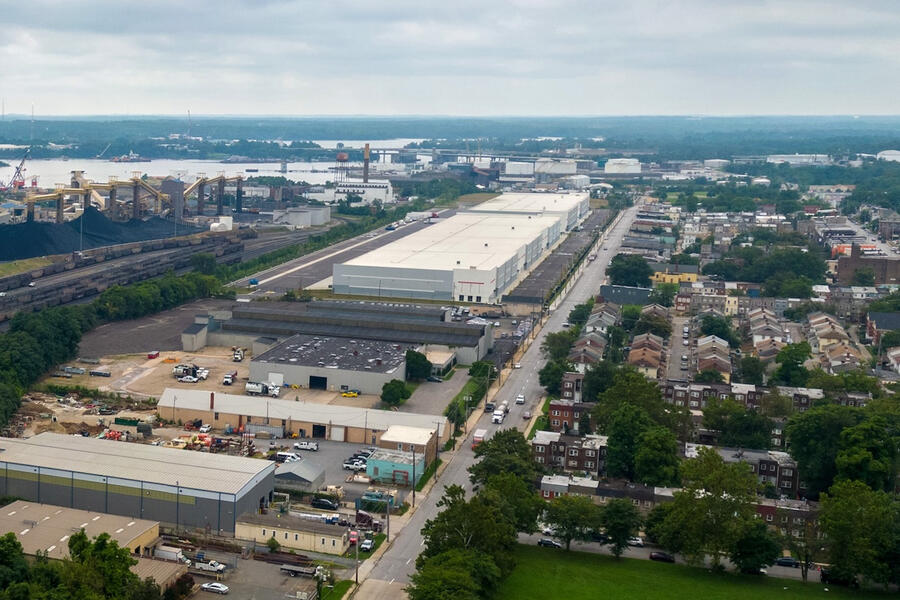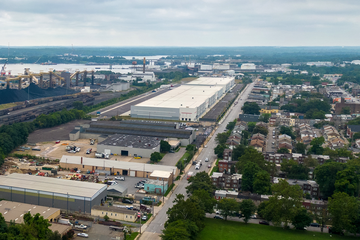- Name
- Danielle Underferth
- dunderf1@jh.edu
- Name
- Kris Henry
- khenry39@jhu.edu
Bulldozer activity involving coal at an open-air facility at the Port of Baltimore is closely linked to air pollutants in the adjacent neighborhood of Curtis Bay, according to a community-driven study co-led by researchers at the Johns Hopkins Bloomberg School of Public Health and South Baltimore community members.
The residential neighborhood, surrounded by heavy industrial activity and diesel truck, train, and ship traffic, is subject to a variety of air pollution. The study found that levels of certain air pollutants—including particulate matter and black carbon—were highest of all, on average, when there was both bulldozer activity and wind blowing from the coal terminal.
Key Takeaways
- Researchers have shown a connection between air pollution concerns in Baltimore's Curtis Bay neighborhood and activity at a nearby coal terminal at the Port of Baltimore
- Increases in black carbon and other particulate matter pollution corresponded closely to bulldozer activity at the terminal and to times when the wind was blowing toward the neighborhood
- Continued exposure to particulate matter and black carbon air pollution at sufficient levels has been linked to adverse health impacts, including respiratory, cardiovascular, neurological, and reproductive diseases.
For their study, the research team set up air-pollutant monitors in and around Curtis Bay, and a camera in view of the terminal to monitor bulldozer activity. The researchers found that increases in black carbon and other particulate matter pollution corresponded closely to bulldozer activity—piling coal into large mounds and helping load coal onto ships for transport—and to times when the wind was blowing from the terminal toward Curtis Bay.
The results support Curtis Bay residents' complaints about coal-related air pollution from the terminal. Exposure to coal dust has been linked to respiratory diseases among coal miners. While less is known about coal dust exposure in community settings, continued exposure to particulate matter and black carbon air pollution at sufficient levels has been linked to adverse health impacts, including respiratory, cardiovascular, neurological, and reproductive diseases.
The study was published online July 21 in the journal Air Quality, Atmosphere & Health.
"Curtis Bay residents have reported for years that they observe black dust that accumulates at their homes and in the community, and they attribute this to coal dust," says study senior author Christopher D. Heaney, associate professor in the Department of Environmental Health and Engineering at the Bloomberg School. "The approach we used in this study revealed that the coal terminal is a significant driver of air pollution burdens in this community."
CSX Corporation's Curtis Bay Piers terminal, originally built in 1882, is a large storage facility for coal brought by rail mainly from coal mines in Pennsylvania and West Virginia principally for transport to India and several Northern European countries. The terminal can handle up to 14 million tons of coal annually and contributes to Baltimore exporting roughly one-third of U.S. annual coal exports.
The Curtis Bay neighborhood is directly to the west of the coal terminal. For decades, people in the community have reported coal dust pollution from the terminal in and around their homes. In 2021, an explosion at the terminal showered the neighborhood with coal dust and led to increased complaints and government scrutiny from federal, state, and local entities.
After the 2021 explosion, Heaney's team, collaborating with South Baltimore community members and scientists from the University of Maryland, the University of California at Davis, the University of Cape Town in South Africa, and the Maryland Department of the Environment, began their research on this issue. Their initial study, published in November 2024, confirmed the presence of coal dust in the Curtis Bay community as far as 1.2 kilometers from the terminal.
In the new study, Heaney and colleagues examined the role of bulldozer activity at the coal terminal and its potential air pollution impacts. They set up 10 meteorological and air pollution-monitoring sites around the Curtis Bay community, as well as a camera programmed to take pictures at regular time intervals to observe visible bulldozer activity at the coal terminal. From July 2022 to July 2023, the researchers gathered minute-by-minute data on the wind direction, the visible presence of bulldozer activity on coal piles at the terminal, and the levels of particulate matter air pollutants of various sizes—including black carbon, a core component of soot and coal dust.
The collaborative research team found that black carbon and particulate matter levels tended to be significantly higher when the wind was blowing from the terminal, compared to when the wind was blowing from other directions. Similarly, particulate matter and black carbon levels were significantly higher, on average, when bulldozers were visibly active on the coal piles. Bulldozer activity was visible, on average, between 35% and 40% of any given day during the study period. Additionally, these air-pollutant levels were highest when both downwind and visible bulldozer activity occurred simultaneously.
The results, the researchers say, are consistent with their prior study and with ongoing concerns of Curtis Bay residents.
The authors note that the findings also suggest that the mitigation measures that have been in place at the coal terminal, including a wind fence and a wetting system for suppressing coal dust, are not adequate.
The researchers emphasize that their work was a collaboration among scientists at different institutions, driven by the concerns of community members within Curtis Bay.
"These findings come at a critical time when Maryland is considering what can be done to reduce this air pollution burden in Curtis Bay," Heaney says. "Options currently on the table include a full enclosure of the terminal as well as denial of the terminal's state permit renewal and a transition away from coal at that site."
"Relation of Wind Direction and Coal Terminal Activity Patterns with Air Pollution Burden in a Community Bordering a Coal Export Terminal, Curtis Bay, Maryland, USA" was co-authored by Lauren Deanes, Bonita Salmerón, Matthew Aubourg, Laura Schmidt, Kristoffer Spicera, Caila Wagara, Gregory Sawtell, Carlos Sanchez-Gonzalez, David Jones, Angela Shaneyfelt, David Hagan, David McClosky, Nicholas Spada, Russell Dickerson, Vivek Ravichandran, Sacoby Wilson, Anik Burman, Abhirup Datta, and Christopher Heaney.
This study was supported by the National Institute of En?vironmental Health Sciences (NIEHS) P30 Center for Community Health: Addressing Regional Maryland Environmental Determinants of Disease at Johns Hopkins University (P30ES032756); the NIEHS-funded UC Davis Environmental Health Science Center Core (P30ES023513); NIEHS Training Program in Environmental Health Sciences (T32ES007141); NIEHS (R01ES033739); the National Institute for Occupa?tional Safety and Health Education and Research Center (T42OH0008428); the University of Maryland Challenge Grant and the Maryland Depart?ment of the Environment. The Community of Curtis Bay Association, Dickerson, Ravichandran, and Wilson were supported by the U.S. Environmental Protection Agency American Rescue Plan Enhanced Air Qual?ity Monitoring for Communities (U00P46009520). Co-authors Salmerón, Aubourg, Schmidt, Spicer, and Heaney were supported by the Johns Hopkins Community Science and Innovation for Environmental Justice (CSI EJ) Initiative.
Posted in Science+Technology, Community
Tagged community, environmental health









